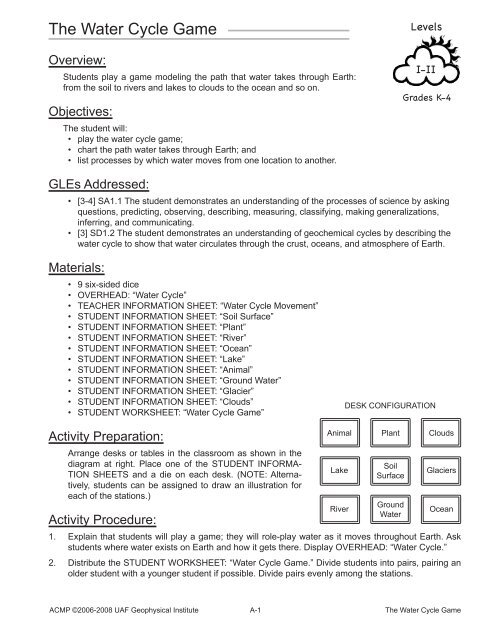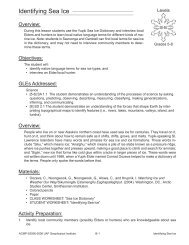The Water Cycle Game - Arctic Climate Modeling Program
The Water Cycle Game - Arctic Climate Modeling Program
The Water Cycle Game - Arctic Climate Modeling Program
You also want an ePaper? Increase the reach of your titles
YUMPU automatically turns print PDFs into web optimized ePapers that Google loves.
<strong>The</strong> <strong>Water</strong> <strong>Cycle</strong> <strong>Game</strong><br />
Overview:<br />
Students play a game modeling the path that water takes through Earth:<br />
from the soil to rivers and lakes to clouds to the ocean and so on.<br />
Objectives:<br />
<strong>The</strong> student will:<br />
• play the water cycle game;<br />
• chart the path water takes through Earth; and<br />
• list processes by which water moves from one location to another.<br />
Levels<br />
I-II<br />
Grades K-4<br />
GLEs Addressed:<br />
• [3-4] SA1.1 <strong>The</strong> student demonstrates an understanding of the processes of science by asking<br />
questions, predicting, observing, describing, measuring, classifying, making generalizations,<br />
inferring, and communicating.<br />
• [3] SD1.2 <strong>The</strong> student demonstrates an understanding of geochemical cycles by describing the<br />
water cycle to show that water circulates through the crust, oceans, and atmosphere of Earth.<br />
Materials:<br />
• 9 six-sided dice<br />
• OVERHEAD: “<strong>Water</strong> <strong>Cycle</strong>”<br />
• TEACHER INFORMATION SHEET: “<strong>Water</strong> <strong>Cycle</strong> Movement”<br />
• STUDENT INFORMATION SHEET: “Soil Surface”<br />
• STUDENT INFORMATION SHEET: “Plant”<br />
• STUDENT INFORMATION SHEET: “River”<br />
• STUDENT INFORMATION SHEET: “Ocean”<br />
• STUDENT INFORMATION SHEET: “Lake”<br />
• STUDENT INFORMATION SHEET: “Animal”<br />
• STUDENT INFORMATION SHEET: “Ground <strong>Water</strong>”<br />
• STUDENT INFORMATION SHEET: “Glacier”<br />
• STUDENT INFORMATION SHEET: “Clouds”<br />
• STUDENT WORKSHEET: “<strong>Water</strong> <strong>Cycle</strong> <strong>Game</strong>”<br />
DESK CONFIGURATION<br />
Activity Preparation:<br />
Arrange desks or tables in the classroom as shown in the<br />
diagram at right. Place one of the STUDENT INFORMA-<br />
TION SHEETS and a die on each desk. (NOTE: Alternatively,<br />
students can be assigned to draw an illustration for<br />
each of the stations.)<br />
Activity Procedure:<br />
Animal Plant Clouds<br />
1. Explain that students will play a game; they will role-play water as it moves throughout Earth. Ask<br />
students where water exists on Earth and how it gets there. Display OVERHEAD: “<strong>Water</strong> <strong>Cycle</strong>.”<br />
2. Distribute the STUDENT WORKSHEET: “<strong>Water</strong> <strong>Cycle</strong> <strong>Game</strong>.” Divide students into pairs, pairing an<br />
older student with a younger student if possible. Divide pairs evenly among the stations.<br />
Lake<br />
River<br />
Soil<br />
Surface<br />
Ground<br />
<strong>Water</strong><br />
Glaciers<br />
Ocean<br />
ACMP ©2006-2008 UAF Geophysical Institute A-1 <strong>The</strong> <strong>Water</strong> <strong>Cycle</strong> <strong>Game</strong>
3. Explain that when the signal is given, students will roll the die at the station. If more than one student<br />
is at a station, students will need to take turns rolling the die. Students should read the number on the<br />
die and match it to the chart on the sheet on the table. <strong>The</strong> chart will indicate where to go next. For<br />
example, if a student rolls a 3 at the Soil Surface Station, he or she will move to the Ground <strong>Water</strong><br />
station next.<br />
4. As students move from station to station, they should chart their paths on their STUDENT WORK-<br />
SHEETS.<br />
5. At the next station, the student should roll the die and move according to the chart at the new station.<br />
Each station will have a different chart.<br />
6. Sometimes the chart will indicate that a student should stay at that station. In that case, the student<br />
should mark an X on that location on his or her chart and roll again. By the end of the game, a student<br />
may have several X’s next to a particular station. At the end of the game, students will share paths<br />
with each other.<br />
7. Play a mock round to make sure students understand the rules.<br />
8. Indicate that students should begin and assist as necessary. Allow students to play for 10-15 minutes.<br />
(NOTE: Level I students may require more play time.)<br />
9. Draw a replica of the blank STUDENT WORKSHEET: “<strong>Water</strong> <strong>Cycle</strong> <strong>Game</strong>” on the board or use the<br />
OVERHEAD: “<strong>Water</strong> <strong>Cycle</strong>.” Invite students to share the path they took. Compare students’ paths.<br />
10. If needed, introduce the term “water cycle.” Explain that a cycle is something that repeats over and<br />
over. For example, the year is a cycle. <strong>The</strong> twelve months of the year repeat over and over every year.<br />
<strong>Water</strong> moves on Earth in a cycle as well. Even though water moves in a variety of ways, it always<br />
returns to its original position.<br />
11. Ask students to answer the following questions based on the paths that were taken during the water<br />
cycle game. List student ideas on the board and discuss as a class.<br />
A. Where can water from a plant go?<br />
B. How does water get to a river?<br />
C. Where can water go from a glacier?<br />
D. How does water get to a cloud?<br />
Critical Thinking Concept: Think-Pair-Share Method. Divide students into pairs or small groups. Assign<br />
each group a station. Ask groups to list ways that water is carried or moves from that station to<br />
the other stations. Remind students that water does not go to every station, just the ones that are on<br />
the chart. For example, water moves from a river to an animal when the animal drinks the water. Ask<br />
students to share ideas with the class. See TEACHER INFORMATION SHEET: “<strong>Water</strong> <strong>Cycle</strong> Movement”<br />
for more information.<br />
Answers:<br />
Answers will vary, however students should only illustrate paths that are allowed within the rules of<br />
the game.<br />
ACMP ©2006-2008 UAF Geophysical Institute A-2 <strong>The</strong> <strong>Water</strong> <strong>Cycle</strong> <strong>Game</strong>
<strong>Water</strong> <strong>Cycle</strong> Movement<br />
Teacher Information Sheet<br />
Location Moves To Process of Movement<br />
Soil Surface<br />
Plant<br />
River<br />
Clouds<br />
Ocean<br />
Lake<br />
Animal<br />
Ground <strong>Water</strong><br />
Glacier<br />
Plant<br />
River<br />
Ground <strong>Water</strong><br />
Clouds<br />
Soil Surface<br />
Clouds<br />
Plant<br />
Lake<br />
Ground <strong>Water</strong><br />
Ocean<br />
Animal<br />
Clouds<br />
River<br />
Soil Surface<br />
Glacier<br />
Lake<br />
Ocean<br />
Clouds<br />
River<br />
Clouds<br />
Ocean<br />
Ground <strong>Water</strong><br />
Animal<br />
River<br />
Clouds<br />
Lake<br />
Soil Surface<br />
Clouds<br />
Animal<br />
River<br />
Lake<br />
Ground <strong>Water</strong><br />
Ground <strong>Water</strong><br />
Clouds<br />
River<br />
Glacier<br />
<strong>The</strong> roots of plants absorb water.<br />
<strong>Water</strong> runs off the soil into a river.<br />
<strong>Water</strong> is filtered through the soil to the ground water.<br />
<strong>Water</strong> is heated until it evaporates and forms clouds.<br />
<strong>Water</strong> stays on the surface of the soil.<br />
<strong>Water</strong> leaves the plant in the form of water vapor through<br />
transpiration and forms clouds.<br />
<strong>The</strong> plant uses water.<br />
<strong>Water</strong> flows from a river to a lake.<br />
<strong>Water</strong> is filtered through the soil to the ground water.<br />
<strong>Water</strong> flows from a river to the ocean.<br />
An animal drinks the water.<br />
<strong>Water</strong> is heated until it evaporates and forms clouds.<br />
<strong>Water</strong> remains in the current of the river.<br />
<strong>Water</strong> condenses, precipitates, and falls onto the soil.<br />
<strong>Water</strong> falls as snow onto a glacier and becomes part of the glacier.<br />
<strong>Water</strong> condenses, precipitates, and falls into a lake.<br />
<strong>Water</strong> condenses, precipitates, and falls into the ocean.<br />
<strong>Water</strong> remains as a water droplet within a cloud.<br />
<strong>Water</strong> condenses, precipitates, and falls into a river.<br />
<strong>Water</strong> is heated until it evaporates and forms clouds.<br />
<strong>Water</strong> remains in the ocean.<br />
<strong>Water</strong> is filtered through the soil to the ground water.<br />
An animal drinks the water.<br />
<strong>Water</strong> flows into a river from the lake.<br />
<strong>Water</strong> is heated until it evaporates and forms clouds.<br />
<strong>Water</strong> remains in the lake.<br />
Animals excrete water through urine and feces onto the soil.<br />
<strong>Water</strong> is emitted by animals through respiration and evaporation and<br />
rises to form clouds.<br />
Animals use water.<br />
<strong>Water</strong> filters through the soil to a river.<br />
<strong>Water</strong> filters through the soil to a lake.<br />
<strong>Water</strong> stays underground.<br />
Ice melts and the water filters underground.<br />
Ice evaporates through the process of sublimation. <strong>The</strong> water vapor<br />
forms clouds.<br />
Ice melts and flows into a river.<br />
Ice remains in the glacier.<br />
ACMP ©2006-2008 UAF Geophysical Institute A-3 <strong>The</strong> <strong>Water</strong> <strong>Cycle</strong> <strong>Game</strong>
Soil Surface<br />
Student Information Sheet<br />
Levels<br />
I-II<br />
SOIL SURFACE<br />
1 Plant<br />
2 River<br />
3 Ground <strong>Water</strong><br />
4 Clouds<br />
Ground <strong>Water</strong><br />
5 Soil Surface<br />
6 Soil Surface<br />
ACMP ©2006-2008 UAF Geophysical Institute A-4 <strong>The</strong> <strong>Water</strong> <strong>Cycle</strong> <strong>Game</strong>
Plant<br />
Student Information Sheet<br />
Levels<br />
I-II<br />
PLANT<br />
1 Clouds<br />
2 Clouds<br />
3 Clouds<br />
4 Clouds<br />
5 Plant<br />
6 Plant<br />
ACMP ©2006-2008 UAF Geophysical Institute A-5 <strong>The</strong> <strong>Water</strong> <strong>Cycle</strong> <strong>Game</strong>
River<br />
Student Information Sheet<br />
Levels<br />
I-II<br />
RIVER<br />
1 Clouds<br />
2 River<br />
3 Lake<br />
4 Ground <strong>Water</strong><br />
Ground <strong>Water</strong><br />
5 Ocean<br />
6 Animal<br />
ACMP ©2006-2008 UAF Geophysical Institute A-6 <strong>The</strong> <strong>Water</strong> <strong>Cycle</strong> <strong>Game</strong>
Clouds<br />
Student Information Sheet<br />
Levels<br />
I-II<br />
CLOUDS<br />
1 Clouds<br />
2 Glacier<br />
3 Lake<br />
4 Soil Surface<br />
5 Ocean<br />
6 River<br />
ACMP ©2006-2008 UAF Geophysical Institute A-7 <strong>The</strong> <strong>Water</strong> <strong>Cycle</strong> <strong>Game</strong>
Ocean<br />
Student Information Sheet<br />
Levels<br />
I-II<br />
OCEAN<br />
1 Clouds<br />
2 Clouds<br />
3 Ocean<br />
4 Ocean<br />
5 Ocean<br />
6 Ocean<br />
ACMP ©2006-2008 UAF Geophysical Institute A-8 <strong>The</strong> <strong>Water</strong> <strong>Cycle</strong> <strong>Game</strong>
Lake<br />
Student Information Sheet<br />
Levels<br />
I-II<br />
LAKE<br />
1 Ground <strong>Water</strong><br />
Ground <strong>Water</strong><br />
2 Clouds<br />
3 Animal<br />
4 River<br />
5 Lake<br />
6 Lake<br />
ACMP ©2006-2008 UAF Geophysical Institute A-9 <strong>The</strong> <strong>Water</strong> <strong>Cycle</strong> <strong>Game</strong>
Animal<br />
Student Information Sheet<br />
Levels<br />
I-II<br />
ANIMAL<br />
1 Clouds<br />
2 Clouds<br />
3 Clouds<br />
4 Animal<br />
5 Soil Surface<br />
6 Soil Surface<br />
ACMP ©2006-2008 UAF Geophysical Institute A-10 <strong>The</strong> <strong>Water</strong> <strong>Cycle</strong> <strong>Game</strong>
Ground <strong>Water</strong><br />
Student Information Sheet<br />
Levels<br />
I-II<br />
Ground <strong>Water</strong><br />
GROUND WATER<br />
1 River<br />
2 Lake<br />
3 Lake<br />
4 Ground <strong>Water</strong><br />
Ground <strong>Water</strong><br />
5 Ground <strong>Water</strong><br />
Ground <strong>Water</strong><br />
6 Ground <strong>Water</strong><br />
Ground <strong>Water</strong><br />
ACMP ©2006-2008 UAF Geophysical Institute A-11 <strong>The</strong> <strong>Water</strong> <strong>Cycle</strong> <strong>Game</strong>
Glacier<br />
Student Information Sheet<br />
Levels<br />
I-II<br />
GLACIER<br />
1 Glacier<br />
2 Glacier<br />
3 Glacier<br />
4 Ground <strong>Water</strong><br />
Ground <strong>Water</strong><br />
5 Clouds<br />
6 River<br />
ACMP ©2006-2008 UAF Geophysical Institute A-12 <strong>The</strong> <strong>Water</strong> <strong>Cycle</strong> <strong>Game</strong>
Name:_______________________<br />
<strong>Water</strong> <strong>Cycle</strong> <strong>Game</strong><br />
Student Worksheet<br />
Levels<br />
I-II<br />
clouds<br />
glacier<br />
animal<br />
plants<br />
river<br />
soil surface<br />
lake<br />
ocean<br />
ground water<br />
Directions: Chart the path you take during the game on the picture above.<br />
ACMP ©2006-2008 UAF Geophysical Institute A-13 <strong>The</strong> <strong>Water</strong> <strong>Cycle</strong> <strong>Game</strong>
<strong>Water</strong> <strong>Cycle</strong><br />
Overhead<br />
clouds<br />
glacier<br />
animal<br />
plants<br />
river<br />
soil surface<br />
lake<br />
ocean<br />
ground water<br />
ACMP ©2006-2008 UAF Geophysical Institute <strong>The</strong> <strong>Water</strong> <strong>Cycle</strong> <strong>Game</strong>
















